Page 277 of 345
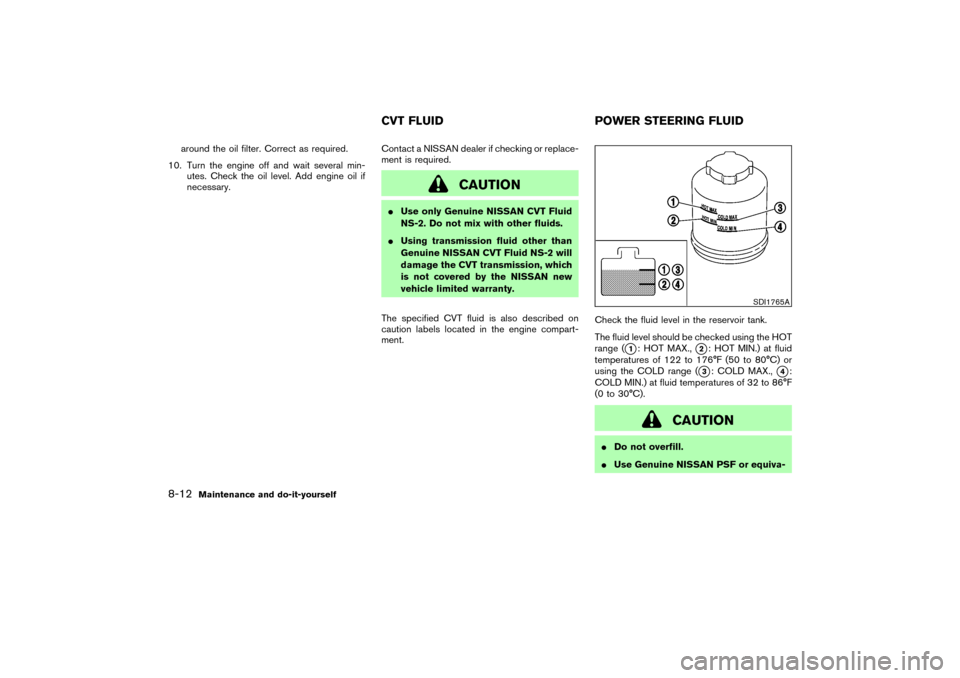
around the oil filter. Correct as required.
10. Turn the engine off and wait several min-
utes. Check the oil level. Add engine oil if
necessary.Contact a NISSAN dealer if checking or replace-
ment is required.
CAUTION
�Use only Genuine NISSAN CVT Fluid
NS-2. Do not mix with other fluids.
�Using transmission fluid other than
Genuine NISSAN CVT Fluid NS-2 will
damage the CVT transmission, which
is not covered by the NISSAN new
vehicle limited warranty.
The specified CVT fluid is also described on
caution labels located in the engine compart-
ment.Check the fluid level in the reservoir tank.
The fluid level should be checked using the HOT
range (
�1: HOT MAX.,
�2: HOT MIN.) at fluid
temperatures of 122 to 176°F (50 to 80°C) or
using the COLD range (�3: COLD MAX.,
�4:
COLD MIN.) at fluid temperatures of 32 to 86°F
(0 to 30°C).
CAUTION
�Do not overfill.
�Use Genuine NISSAN PSF or equiva-
SDI1765A
CVT FLUID POWER STEERING FLUID
8-12
Maintenance and do-it-yourself
�
06.7.5/Z50-D/V5.0
�
Page 279 of 345
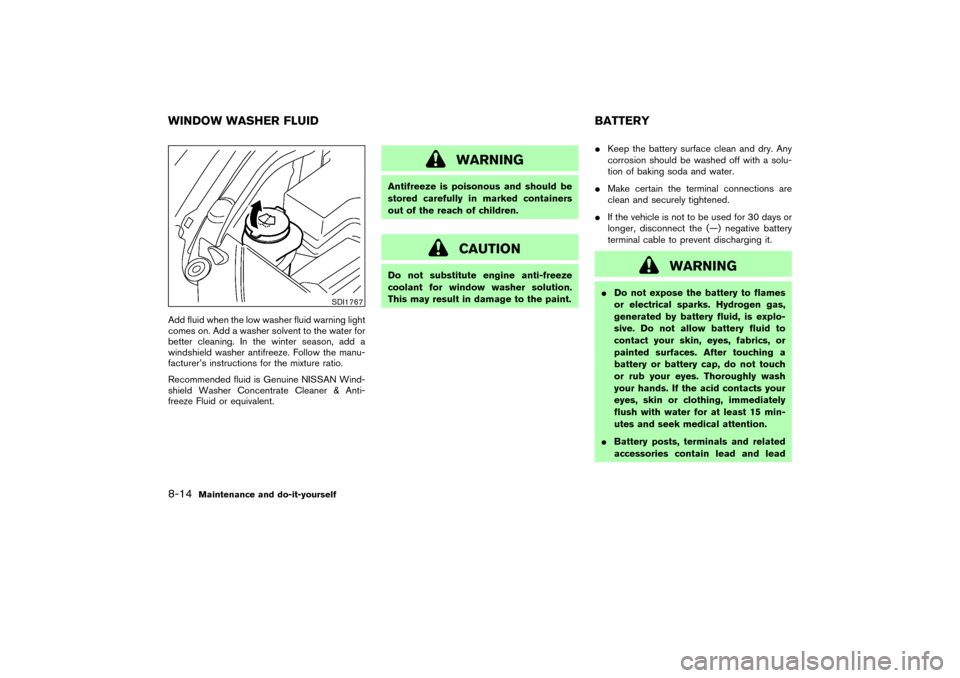
Add fluid when the low washer fluid warning light
comes on. Add a washer solvent to the water for
better cleaning. In the winter season, add a
windshield washer antifreeze. Follow the manu-
facturer’s instructions for the mixture ratio.
Recommended fluid is Genuine NISSAN Wind-
shield Washer Concentrate Cleaner & Anti-
freeze Fluid or equivalent.
WARNING
Antifreeze is poisonous and should be
stored carefully in marked containers
out of the reach of children.
CAUTION
Do not substitute engine anti-freeze
coolant for window washer solution.
This may result in damage to the paint.�Keep the battery surface clean and dry. Any
corrosion should be washed off with a solu-
tion of baking soda and water.
�Make certain the terminal connections are
clean and securely tightened.
�If the vehicle is not to be used for 30 days or
longer, disconnect the (—) negative battery
terminal cable to prevent discharging it.
WARNING
�Do not expose the battery to flames
or electrical sparks. Hydrogen gas,
generated by battery fluid, is explo-
sive. Do not allow battery fluid to
contact your skin, eyes, fabrics, or
painted surfaces. After touching a
battery or battery cap, do not touch
or rub your eyes. Thoroughly wash
your hands. If the acid contacts your
eyes, skin or clothing, immediately
flush with water for at least 15 min-
utes and seek medical attention.
�Battery posts, terminals and related
accessories contain lead and lead
SDI1767
WINDOW WASHER FLUID BATTERY8-14
Maintenance and do-it-yourself
�
06.7.5/Z50-D/V5.0
�
Page 280 of 345
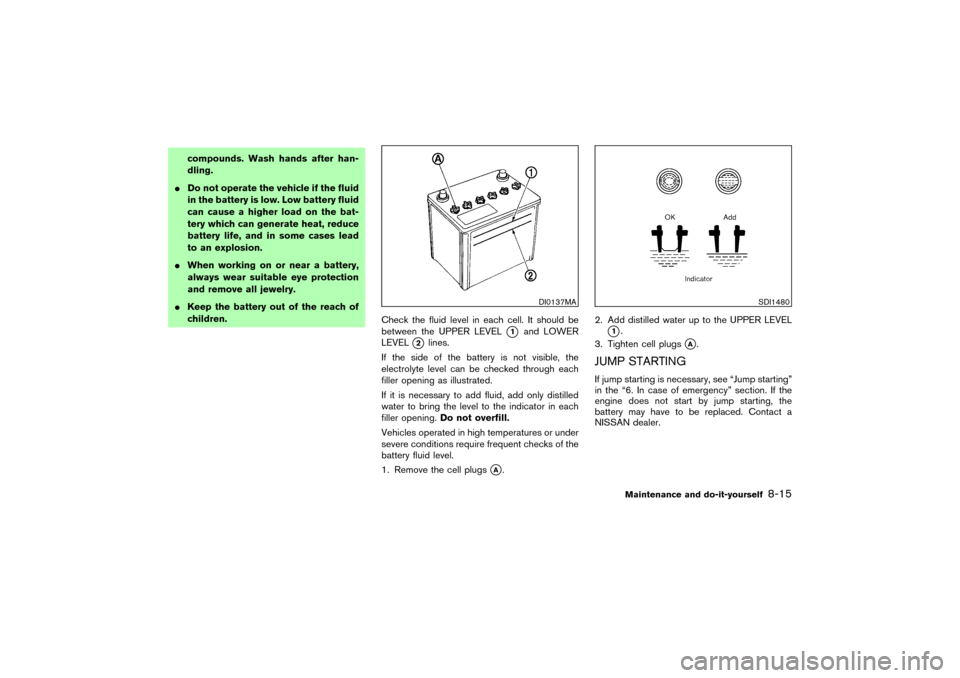
compounds. Wash hands after han-
dling.
�Do not operate the vehicle if the fluid
in the battery is low. Low battery fluid
can cause a higher load on the bat-
tery which can generate heat, reduce
battery life, and in some cases lead
to an explosion.
�When working on or near a battery,
always wear suitable eye protection
and remove all jewelry.
�Keep the battery out of the reach of
children.
Check the fluid level in each cell. It should be
between the UPPER LEVEL
�1
and LOWER
LEVEL
�2
lines.
If the side of the battery is not visible, the
electrolyte level can be checked through each
filler opening as illustrated.
If it is necessary to add fluid, add only distilled
water to bring the level to the indicator in each
filler opening.Do not overfill.
Vehicles operated in high temperatures or under
severe conditions require frequent checks of the
battery fluid level.
1. Remove the cell plugs
�A.2. Add distilled water up to the UPPER LEVEL
�1.
3. Tighten cell plugs
�A.
JUMP STARTINGIf jump starting is necessary, see “Jump starting”
in the “6. In case of emergency” section. If the
engine does not start by jump starting, the
battery may have to be replaced. Contact a
NISSAN dealer.
DI0137MA
SDI1480
Maintenance and do-it-yourself
8-15
�
06.7.5/Z50-D/V5.0
�
Page 281 of 345
WARNING
Be sure the ignition key is in the OFF or
LOCK position. The engine could rotate
unexpectedly.
1. Power steering oil pump
2. Idler pulley
3. Alternator
4. Crankshaft pulley
5. Air conditioner compressor
�: Tension checking pointsVisually inspect each belt for signs of unusual
wear, cuts, fraying, oil adhesion or looseness. If
the belt is in poor condition or loose, have it
replaced or adjusted by a NISSAN dealer.
Have the belts checked regularly for condition
and tension.
WARNING
Be sure the engine and ignition switch
are off and that the parking brake is
engaged securely.
CAUTION
Be sure to use the correct socket to
remove the spark plugs. An incorrect
socket can damage the spark plugs.
SDI0141B
DRIVE BELTS SPARK PLUGS8-16
Maintenance and do-it-yourself
�
06.7.5/Z50-D/V5.0
�
Page 282 of 345
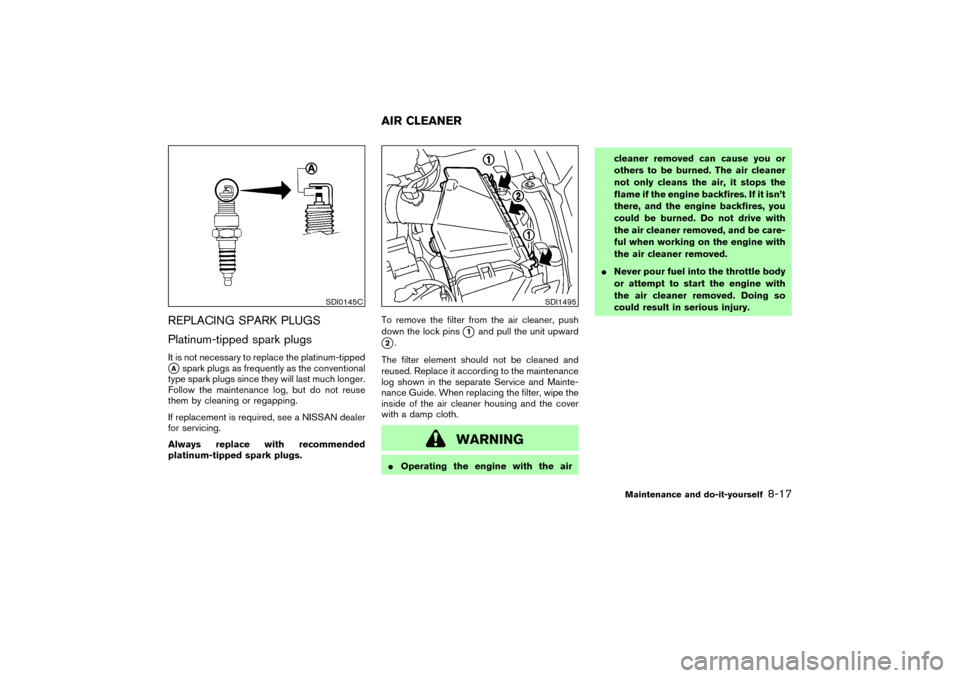
REPLACING SPARK PLUGS
Platinum-tipped spark plugsIt is not necessary to replace the platinum-tipped�Aspark plugs as frequently as the conventional
type spark plugs since they will last much longer.
Follow the maintenance log, but do not reuse
them by cleaning or regapping.
If replacement is required, see a NISSAN dealer
for servicing.
Always replace with recommended
platinum-tipped spark plugs.To remove the filter from the air cleaner, push
down the lock pins
�1
and pull the unit upward
�2.
The filter element should not be cleaned and
reused. Replace it according to the maintenance
log shown in the separate Service and Mainte-
nance Guide. When replacing the filter, wipe the
inside of the air cleaner housing and the cover
with a damp cloth.
WARNING
�Operating the engine with the aircleaner removed can cause you or
others to be burned. The air cleaner
not only cleans the air, it stops the
flame if the engine backfires. If it isn’t
there, and the engine backfires, you
could be burned. Do not drive with
the air cleaner removed, and be care-
ful when working on the engine with
the air cleaner removed.
�Never pour fuel into the throttle body
or attempt to start the engine with
the air cleaner removed. Doing so
could result in serious injury.
SDI0145C
SDI1495
AIR CLEANER
Maintenance and do-it-yourself
8-17
�
06.7.5/Z50-D/V5.0
�
Page 283 of 345
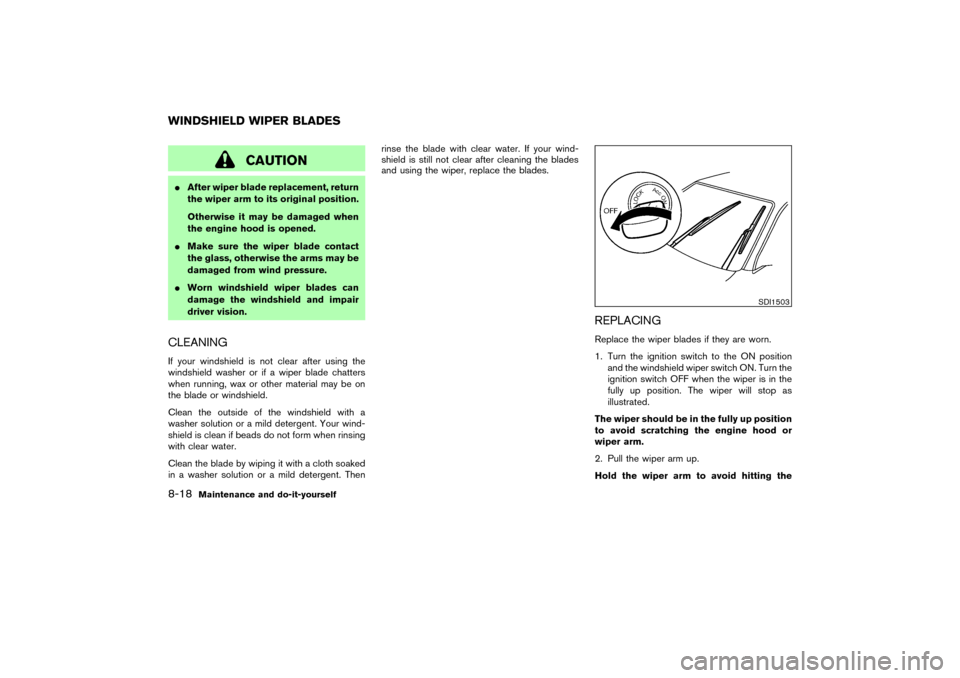
CAUTION
�After wiper blade replacement, return
the wiper arm to its original position.
Otherwise it may be damaged when
the engine hood is opened.
�Make sure the wiper blade contact
the glass, otherwise the arms may be
damaged from wind pressure.
�Worn windshield wiper blades can
damage the windshield and impair
driver vision.CLEANINGIf your windshield is not clear after using the
windshield washer or if a wiper blade chatters
when running, wax or other material may be on
the blade or windshield.
Clean the outside of the windshield with a
washer solution or a mild detergent. Your wind-
shield is clean if beads do not form when rinsing
with clear water.
Clean the blade by wiping it with a cloth soaked
in a washer solution or a mild detergent. Thenrinse the blade with clear water. If your wind-
shield is still not clear after cleaning the blades
and using the wiper, replace the blades.
REPLACINGReplace the wiper blades if they are worn.
1. Turn the ignition switch to the ON position
and the windshield wiper switch ON. Turn the
ignition switch OFF when the wiper is in the
fully up position. The wiper will stop as
illustrated.
The wiper should be in the fully up position
to avoid scratching the engine hood or
wiper arm.
2. Pull the wiper arm up.
Hold the wiper arm to avoid hitting the
SDI1503
WINDSHIELD WIPER BLADES8-18
Maintenance and do-it-yourself
�
06.7.5/Z50-D/V5.0
�
Page 286 of 345
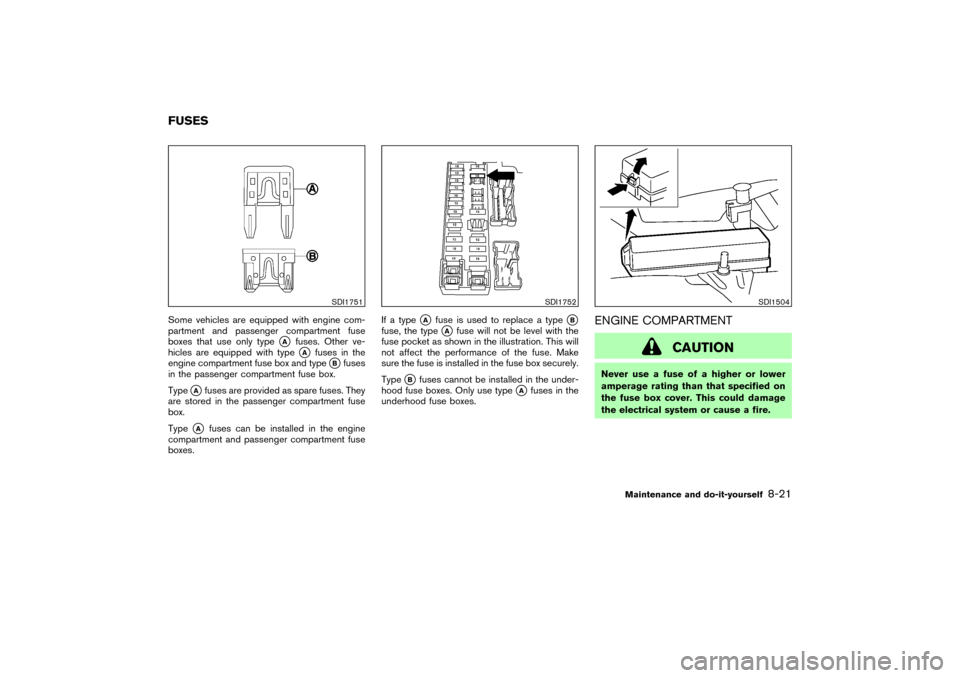
Some vehicles are equipped with engine com-
partment and passenger compartment fuse
boxes that use only type
�A
fuses. Other ve-
hicles are equipped with type�A
fuses in the
engine compartment fuse box and type
�Bfuses
in the passenger compartment fuse box.
Type
�Afuses are provided as spare fuses. They
are stored in the passenger compartment fuse
box.
Type
�A
fuses can be installed in the engine
compartment and passenger compartment fuse
boxes.If a type
�A
fuse is used to replace a type
�B
fuse, the type
�A
fuse will not be level with the
fuse pocket as shown in the illustration. This will
not affect the performance of the fuse. Make
sure the fuse is installed in the fuse box securely.
Type
�B
fuses cannot be installed in the under-
hood fuse boxes. Only use type
�A
fuses in the
underhood fuse boxes.
ENGINE COMPARTMENT
CAUTION
Never use a fuse of a higher or lower
amperage rating than that specified on
the fuse box cover. This could damage
the electrical system or cause a fire.
SDI1751
SDI1752
SDI1504
FUSES
Maintenance and do-it-yourself
8-21
�
06.7.5/Z50-D/V5.0
�
Page 287 of 345
If any electrical equipment does not operate,
check for an open fuse.
1. Be sure the ignition switch and headlight
switch are OFF.
2. Open the engine hood.
3. Remove the fusible link cover.
4. Remove the fuse with the fuse puller.
5. If the fuse is open
�A, replace it with a new
fuse
�B.
6. If a new fuse also opens, have the electrical
system checked and repaired by a NISSAN
dealer.
Fusible linksIf any electrical equipment does not operate and
fuses are in good condition, check the fusible
links. If any of these fusible links are melted,
replace only with genuine NISSAN parts.
SDI1753
Type A
SDI1754
Type B
8-22
Maintenance and do-it-yourself
�
06.7.5/Z50-D/V5.0
�